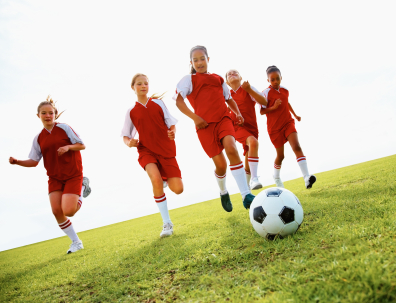Whether there are gender differences in the response of athletes to concussive injury has been an active area of research in recent years, but one which "remains somewhat murky, with general trends but few definitive answers," [8] and which more research is needed. [22]
Higher rates
The evidence so far appears to suggest that girls suffer concussions at a higher rate than boys in similar sports:
- Soccer:
- A 2007 study [1] found that the concussion rate for girls was 68 percent higher than boys;
- A 2011 study [2] found that the concussion rate for girls in high school soccer (0.35 per 1000 participations by an athlete in a practice or competition or athlete-exposures (AEs) was double that of boys (.017 per 1000 AEs);
- A 2013 study [21] of data collected by the author of a report by Safe Kids Worldwide [22] and the Consumer Product Safety Commission through its National Electronic Injury Surveillance System (NEISS) found that girls in soccer were more likely than boys to be seen in hospital emergency rooms as a proportion of all sports-related injuries.
- Basketball:
- The 2007 study found the concussion rates in high school basketball were almost 3 times higher for girls than boys.[1]
- The 2011 study[2] reported that the concussion rate for girls was 1.7 times higher than for boys.
- The 2013 study[21,22] found that 11.5% of injuries seen in girls basketball were concussions compared to 7.2% for boys.
- Lacrosse: Despite the fact that girls, unlike boys, do not wear helmets, 18.7% of girl lacrosse players seen for injuries in the emergency department are seen for concussions, compared to 15.6% of boy lacrosse players.[21]
Gender differences in concussion severity?
Whether girls more symptoms at baseline and post-concussion, have better verbal memory scores but poorer visual memory scores at baseline, and experience greater levels of acute, postconcussive neurocognitive impairment remains unclear.
A number of recent studies have reported that female athletes - high school and college - report more post-injury symptoms after concussion,[3,4,5] and also perform worse than male athletes on post-concussion tests of visual memory. [4,7]
A 2007 study [1] found longer recovery times, while a 2009 study [3] found that girls with a previous history of concussions reported more and different concussion symptoms (particularly headache), although admitting to the possibility that male and female athletes may report symptoms differently due to psychological or personality factors not directly related to concussion.
Two more recent studies, however, one from 2011 [2] and one in 2012 [8], however, found no gender differences in response to concussion.
The 2011 study [2] found no difference in the number of symptoms reported between male and female athletes, no difference in the time symptoms took to resolve (most reported resolution of their symptoms within 3 days of injury) or in the time it took for girls and boys to return to play (median time for RTP was 3 to 6 days). The one difference: girls reported symptoms more subtle and easily missed or attributed to causes other than concussion than those of boys.
In the 2012 study [8], researchers at Vanderbilt University Medical Center and the Vanderbilt Sports Concussion Center studied tightly matched, homogeneous groups of 40 male and 40 female concussed soccer players. They found no gender differences in symptoms at baseline (pre-concussion) or in the first week after concussion, and were unable to replicate the findings of previous studies of mixed groups of athletes from a variety of sports which had reported small but significant gender differences, both at baseline in terms of symptoms and neurocognitive test scores (girls reported more headaches, fatigue, sleep difficulties, irritability, sadness, nervousness, feeling more emotional, feeling slowed down, and difficulty concentrating [9] and on verbal memory tasks, while males perform better on tests of visual memory [7,11] and post-concussion, with girls reporting a higher number of symptoms [3,10] and performing more poorly on neurocognitive testing (significantly slower reaction times). [3,5] The only significant gender-related difference identified by the Vanderbilt researchers was that female high school soccer players reported a greater number of post-concussion symptoms.
The findings "re-emphasizes the fact that concussions aren't just a concern for high school football players; they can happen to athletes playing all types of sports," said Dawn Comstock,Ph.D., co-author of the 2007 study and associate professor in the Department of Epidemiology at the Colorado School of Public Health.
"Generally speaking, the medical profession does not do a very good job in recognizing that female athletes sustain concussions at an equal or even higher rate as males," said MomsTeam.com concussion expert emeritus, Dr. Robert Cantu of Boston University Medical Center and the Sports Legacy Institute in an interview with the New York Times. "It’s flying under the radar. And, as a result, looking for concussions in women is not pursued with the same diligence, and it’s setting girls up for a worse result."








